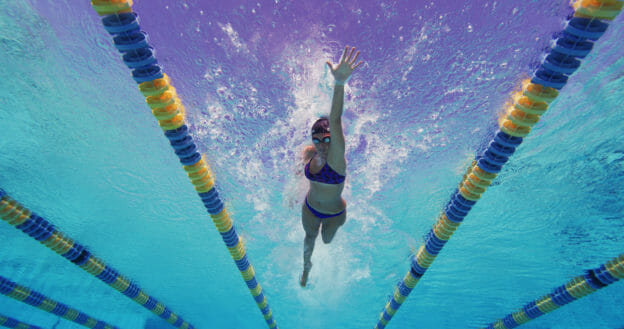Improving your Hip Driven Freestyle Technique
In our new video release this week, we take a very commonly used and popular drill and apply it to a different swimming technique, hip-driven freestyle. Normally, we use this drill in teaching the importance of coupling in shoulder-driven freestyle, but this drill has many other good applications like improving your hip driven freestyle technique.
In hip-driven freestyle, swimmers do not forfeit the important shoulder rotation. They want to get as much of that coupling motion involved in this freestyle technique as possible. In the hip-driven freestyle technique, since fewer strokes are being taken, the swimmer must maximize the propulsion from each arm stroke as much as possible. That means not only using good shoulder rotation. It also means using strong hip rotation and keeping a firm grip on the water throughout the underwater pull. In other words, not out sweeping or in sweeping, but pressing backward, holding on to the water as well as possible through the front and back quadrants. It also means having a strong kick.
To aid the hip-driven freestyle technique, a swimmer can use the six kick/one stroke drill with fins by placing more emphasis on the end of the pull, pushing out the back hard with the hands near the hip. Then, by snapping the hip back, the force of the hand pulling is augmented, increasing the propulsion.
Although the end of the pulling motion in the back quadrant is not the strongest position biomechanically for the freestyle pull, it can become quite strong by simply putting more effort behind it, and by turning the hip aggressively immediately after completing the pull. Even though the force of the pulling hand is over, the coupling with the hip immediately afterward still serves to increase its propulsion. A similar analogy is a long-jumper who swings his arms and runs in the air on the upward trajectory, just after the force of jumping off the whiteboard is completed, but when the force is still acting.
Through Pressure Meter technology, we have learned that the maximum force of the pulling hand can occur in the front quadrant, back quadrant, or at the shoulder, transitioning between the two. It simply depends on what technique the swimmer is using and the relative energy level of the swimmer’s coupling of shoulder or hip rotations.
For those of you who have been debating whether more pulling propulsion or power is gained by a swimmer in the front or back quadrant, you can now rest assured that you are both right. It just depends on the swimmer and the freestyle technique.
Yours in Swimming,
Gary Sr.


Fantastic explanation of hip-driven freestyle, thanks Gary!
You are welcome, Matt! We appreciate you at TRC.
Gary, great explanations of the 3 styles. I was taught the doc c “s” move with hip rotation as a by product. Most of us ended up doing catch up/hitch/hybrid. What does Katie Ladecky use? She’s obviously distance focused. But she’s no slouch in the 100.
Hi Michael. Katie’s freestyle technique continues to evolve through her career. As a young age grouper she was a member of the 2/100+ club- 2 beat kick with a 100+ stroke rate. That all changed in 2015 when her coach Yuri switched her over to Hybrid technique, where she has remained ever since. Lately, as she has gained more strength, she has come to rely more on the pull ….yet still has a strong kick. Her SR is around 90 in the 400 and up. In the 200 she increases the SR to the mid 90’s and in the 100 she goes into the 115 range, at least at the beginning..still with hybrid. In hybrid, the peak forces are different on each arm. On the breathing side her arm reaches a peak force near the shoulder and on the non breath side her peak force is in the front quadrant (most likely). I have never measured her VM or PM, but suspect that is what we would find.